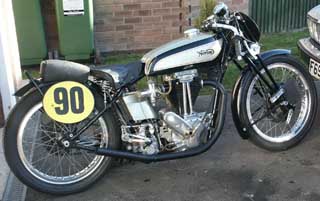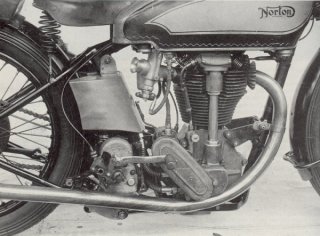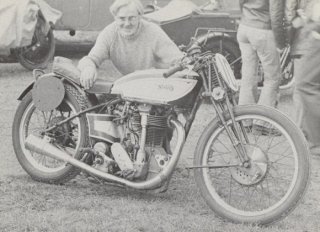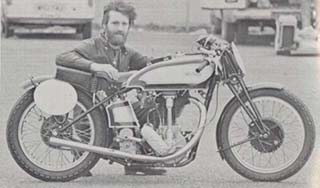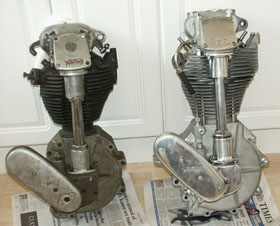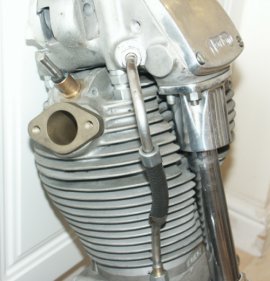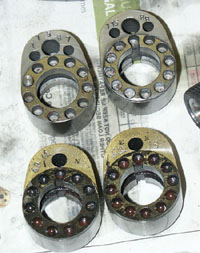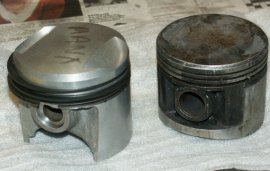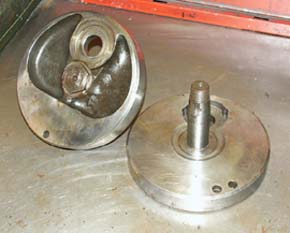Yes well, normal apologies for not updating the web site in the last year, but if you've been following the web site up to now you have probably realised what I'm like, so please forgive me and read on.
That said, I have not been entirely idle since my last
update, but sorry to say for the hardfast Vinny fans, it has not been
on the Lightning restoration.
I offer my standard 'cop out' disclaimer of being a bit of a motorcycling
butterfly, but have long ago stopped trying to fight my whims and just
go with the flow.
Going back a few months, to spring time, I was heavily
'in to' my new toy the Ducati 916. Well, I took that as far as I wanted
to go (see the updated Ducati section) and then afterwards succumbed
to a desire I have been fighting for almost 20 years, to build and race
a pre-war camshaft Norton (International/Manx)..
As I have mentioned, although having a major interest in Vincents, I
have also been heavily involved in Norton singles over the years, particularly
from a racing perspective.
I always maintained that if I got back into any form of competition, I would replace my ES2 based racing motor with a 'proper' sorted cammy engine. Before my road accident in January 2003 I had pulled out my 1938 racer from hibernation and was 'umming and 'arring about its future. I did not consider going back to road racing to be a practical proposition with my current family commitments (two young daughters), but I did fancy the idea of doing the odd sprint or demo meeting. I had also started feeling a bit guilty that I had not used the Norton for about 10 years.
The bike was the bike I had finished racing on and had been built from a bare frame with the hindsight of experience. Almost every bit of the bike was 'special' in some sort of way and though I say so myself, was always admired by those that knew it. Because of this, I always said that I would never sell it, but to the same degree, felt now that I ought to be doing something with it to warrant its place in my overcrowded garage.
Buying the Engine
With a lot of water under the bridge since originally deciding to
do something with the Norton (and a few painful memories), I found
myself in Spring of this year with a little bit of cash saved for
my next car and thoughts again turning to the idea of a Cammy Norton.
You can guess what happened next cant you?, within the blink of an
eye it had gone from a mere pipe dream to me ringing every contact
I know and eventually placing an advert on the Norton Owners Club
Site (excellent site, look at my links for the address), which amazingly,
was answered eventually, by someone offering me a very desirable pre-war
all alloy Norton International engine.
Anyway, to cut a long story short, a couple of weeks later my good friend Andy Phillips and myself found ourselves sat in my kitchen after a long and wet journey, looking at the main components of said engine, loosely assembled, and looking very desirable propped against the fitted kitted units (yes, the wife was out!).
Spec of Engine
To give a bit of detail about the specification of engine, and that
of Norton SOHC engines in general, let me explain.
As most classic bike enthusiasts know, pre-war Norton OHC engines ruled
the roost as far as racing was concerned. The first OHC engine was developed
by Walter Moore in the late 1920's and was an immediate success. However
within 2 years Moore had left for NSU (where he designed almost the
same engine for them!) and Arthur Carroll had designed a new OHC engine
that was to be immortalised as the most successful racing engine ever,
first as the International (Model 30 to give it its proper 500cc designation),
then later as the Manx.
The engine was first produced in 1930 and in International form was to remain visually unchanged (other than minor differences), until it went out of production in the late 1950's. The Manx continued on in its final featherbed racing form for a bit longer, with the last ones being sold in 1962/63.
However, as time went on, the race version of the engine slowly started to grow apart from the road engine, until by the late 1930's genuine race engines (commonly called Manx engines, although I gather the term was never officially used until post war) had moved to DOHC configuration with most major castings different from the road versions and made from magnesium based alloys, and then finally changing in bore and stroke to a much 'squarer' configuration than the original 79 x 100mm that its road going relation kept until the very end.
When I first started looking, I was not too worried about
specification. Ideally, I wanted a good late pre-war 500cc International
engine, but had resigned myself to it being of standard cast iron (head
and barrel) configuration. I would have liked an alloy engine, but know
they are very difficult to find and very expensive. Also, I was intending
to continue running the bike on dope (Methanol) where iron is far less
of a problem, as they run very cool using this fuel
.
Between the years 1930-39 the OHC engine was built in a variety of configurations,
and were continually being developed. However, the most exotic pre-war
SOHC engines, those that evolved into the fabled 'Manx', also employed
many of the main castings made in 'Electron', a magnesium based alloy
(easily identifiable by their blackish matt finish and extremely light
weight). Although the crankcases and cambox are the items most commonly
seen cast in this distinctive looking alloy, I have seen examples of
almost every major casting using it, including some very rare examples
where even the bevel box castings were made from it. Although I would
dearly love one of these very exotic engines, I knew that even if I
had been fortunate enough to find one, there was no way I would have
been able to afford it.
Anyway, when I received a phone call, in response to an advert I had placed, I was more than a little interested when I found that this engine was not only a 1938 engine (at least the number on the crankcase was 1938), but also the barrel was a re-linered alloy barrel, and even better - the head was a very rare bronze skulled alloy head. Yummy.
Having talked to the seller in some detail, and looked closely at the photographs sent me, it was clear that although the engine was still in pieces, it had had a lot of money already spent on it and was supposedly 100% complete.
I wont tell you what I paid for it, but no surprise to say it was a not inconsiderable sum. That said, I knew that to make it a good useable race engine, of the right specification, it was likely to cost me quite a bit more.
As I start to write this article (July 2004), I still haven't fully decided what I am going to use the bike for, but I know that it will be for some form of competition (probably sprinting), so with this in mind I know it is very important not to skimp on the important bits of the rebuild, particularly the crank, head, cambox etc.
As far as specification is concerned, I had pretty much decided that I would attempt to build it in as highly tuned (but reliable) specification as possible, within the constraints of keeping it looking original and being basically reliable. Added to this, at this early stage in development I did not want to alter the bore or stroke but keep to the original 79mm x 100mm dimensions.
Piston :
I intended to run the bike on Methanol, as I did with the ES2 engine,
so a very lumpy piston was called for. The engine came with a very
nice alloy barrel, to match the head, which had been re-linered. It
also came with a standard petrol compression International piston,
which will be nice if I decide to put it on the road, but will not
give the necessary compression ratio for Methanol.
What did turn out to be a problem was that the original piston was
80mm and it seemed likely that although the liner looked new, it had
been bored to match the piston at 80mm. This made life very difficult
because it turns out that it is extremely difficult to get Norton
Manx pistons at this size. 80mm is actually 79mm + 40thou, but by
the late 30's standard Manx size had gone from the classic Norton
bore of 79mm to 79.6, to get the capacity up to 499cc from the standard
490cc. Stu Rogers supplies beautiful forged Omega pistons (with Teflon
skirts), but unfortunately not at 80mm.
Eventually I was able to get an 80mm piston from Ken McIntosh in New Zealand, which again is a beautiful forged creation, this time made by Arias in America. Unfortunately, although a gorgeous piston, the one sent to me turned out to have a couple of thou clearance more than it should have for 80mm. As Ken always bores his barrels to match the piston, this had not been a problem for him, however after careful consideration, we both felt the clearance was slightly excessive, even by my standards (I would much rather have a bit of excess piston noise when cold, than a seize when warm).
Ken was happy to take the piston back, and it was then a case of waiting for Arias to send another batch to Ken, with reduced clearance. In the interim I did look at Stu’s Omega pistons, but unfortunately these were not available in the required oversize. If you look at the accompanying photograph, you will see an interesting comparison between both piston types, both in my opinion both lovely in their own right. The Omega piston on the left is of the latest variety, with Teflon coated sidewall, the Arias piston on the right identifiable by its very high quality of final machining. In truth, both pistons look to be of a far higher quality than any I have used in the past, just a shame to use them really!
Eventually the new Arias piston arrived, and this is the one I have now used for the final build.
When I purchased the engine I had been told the crankshaft had been professionally rebuilt with a new Big End etc etc and was ready to use. I have to say, I am always very sceptical about taking this on trust with crankshafts, particularly when the results of a bad build can be so (shall we say) dramatic! Close inspection of the crankshaft did nothing to change this view so I decided to bite the bullet and send the crankshaft assembly away to Max Nightingale at Alpha Bearings, to have a ganders and (unless it really wasent necessary) fit a new racing big end.
This turned out to be a very wise move, as a week later I received a call from Max to relay the bad news that the flywheel’s Big End journals were badly worn and would require some serious remedial work. This was followed up a half hour later to rescind the first status and replace it with the news that the whole crankshaft was scrap! It turned out that the timing flywheel had a hairline crack and it really wasent economical to go any further. Although this might sound like the sort of news every restorer dreads, it actually made life very easy, I now had no choice but to commission a completely new crankshaft from Alpha’s as well as the Big End they were already going to fit.
Admittedly, I was not a happy man at the time (understatement used here. . . ), but the seller turned out to be a gentleman, and after some discussion offered some rebate from the original sale price (he had had the crankshaft 'professionally' rebuilt, so understandably was not happy himself, having not only paid good money, but also having sold it on described as thus).
Crankshaft Number 2
Once my wallet had come out of Intensive Care I actually felt much happier
about the situation. Although I don’t like chucking money away,
you have to figure that any engine that is going to be used hard should
really have a crankshaft that is totally dependable. Any racing flywheels
that have been about since the 1930’s (70 odd years don’t
forget) are bound to have seen some considerable wear and be questionable
for serious work.
Before finally giving Max the go ahead to start work, I did look around
to see what was available, but in the end the specification quoted by
Max seemed better than anything else close for the same amount of money,
so was happy to give the go ahead for work to commence.
You can see from the accompanying photographs that the quality of the
finished product definitely repaid that trust, because the finish looks
second to none. Alpha’s was able to use the original mainshafts
(which were in very good condition) and these were pressed/bolted to
brand new flywheels machined from very high quality heat treated steel
(I think it is EN18, it was certainly of a higher quality than most
others I am aware of). A new racing (caged roller) big end was fitted
as well.
For the moment I have decided to use an original International conrod,
rather than going the full hog and looking for a Carillo rod, as per
my Vincent. That said, it does look a very nice rod, and I seem to remember
the person I bought it off had had it x-rayed, so should be ok (touch
wood).
Balance Factor and Weight
As part of having the crankshaft rebuilt, Max was able to offer a rebalancing
service as well. I always used to aim for a balance factor of around
60% for Norton ES2 crankshafts, but was none to sure about Manx assemblies.
Having spoken to those in the know, it seems that a figure of 66% is
considered the norm, so I asked for this figure to be used as a starting
point. To achieve this figure, I supplied the weight of the Arias piston
(which is actually quite a heavy piston), and the rest would be calculated
from the connecting rod.
As I already said, the finished crankshaft looks a beautiful quality
job. The only question mark I have about it, is its final weight, in
comparison to an original. Original Inter/Manx flywheels are cast steel
and have a large cutaway cast into them before final machining. The
new ones are machined from billet, then have metal machined from the
conrod side afterwards. I suspect they are actually heavier than the
originals, but as the crankshaft is correctly balanced, I have decided
to try them first, before deciding if it is worth having them lightened
further.
Like most amateur tuners (I use the term ‘tuner’ guardedly!),
I have always associated sprinting/short track racing with using lightened
flywheels rather than the other way round, but when you think about
it logically, you can also argue that heavier flywheels, once wound
up, hold momentum better than standard. Anyway, if truthful, I would
have to admit that I haven’t actually checked the weight, as I
don’t have a fully assembled standard crankshaft to compare against.
The important thing is that it is correctly balanced, so I will suck
it and see before deciding if some weight needs to be removed.
The crankcases are pre-war International crankcases and looked, overall, to be in very good condition. As bought, they had already had a lot of remedial work, with what looks to be both main bearing journals re-sleeved and new bearings fitted. I was told by the seller that this work had been professionally done, and (unlike the flywheels) I would certainly agree, as it looks a very neat job indeed. When purchased the bearing journals had already had the bearing retaining plates fitted, and the screws locating them had been soldered over.
I did want to check that everything underneath looked ok, so I got the blowtorch out and gently removed the solder, revealing the screw heads underneath, allowing them to be easily unscrewed and removed. For those not familiar with Norton racing single engines, they are all fitted with bearing retaining plates, secured to the crankcase by whitworth thread screws. The function of these plates (not surprisingly!) is to stop the bearings loosening from the crankcase housing under racing conditions, and working out from the crankshaft. In reality, I don’t know if the likelihood of this is great anyway (I have certainly never experienced it with any ES2 engines), but I was advised by Stu Rogers that they should not be left out. Interestingly, the sports based International engine has 3 screw fixing bearing retainers (triangular in shape) while the pure racing Manx based crankcases are fitted with four point (square) plates. What is unusual about my engine is that someone had fitted a four plate retainer, but to the timing side crankcase only. Not sure why this is, but it has been nicely done, so not a problem.
Apart from cleaning up all mating faces and carefully removing one or two more noticeable burnishes on the exterior, the crankcases have required very little work to complete. They were even fitted with brand new barrel studs and oil unions, almost unheard of with the engines I have started with in the past!
